PAPERS مقالات by M. R. Javadi Yeganeh
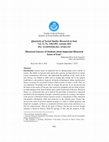
Quarterly of Social Studies Research in Iran, 2022
ntroduction: Literacy plays an important role in making people active citizens of society. The ab... more ntroduction: Literacy plays an important role in making people active citizens of society. The ability to read and write means that a person can keep abreast of current events, communicate effectively, and understand the problems of the world. In the past, literacy was limited to skills such as reading and writing, but in the modern world there is also political, financial, technical, technological, urban, and historical literacy necessary for successful living in urban societies in today’s world. They are very important. For people to be able to navigate the present, to see the present and the future in the context of the past, they need to be equipped with two kinds of tools: an understanding of the field of history and a usable framework of the past. Historical literacy as a framework that can be used by the past helps in historical re-education and leads to the development of people’s historical memory by creating a fair balance in the process of historical literacy between society’s expectations of their education and people’s information, skills and awareness as the ultimate goal. Literacy has moved away from its previous limited meaning as a skill to combat ignorance and found new examples, so there is a connection between social action and literacy as a skill for empowerment. (One of the types of literacy that has not received enough attention is historical literacy. With the passage of time and the progress of life, literacy no longer means the ability to read a word, but the ability to understand the world. Historical literacy not only involves learning historical events, but also attaches importance to strengthening the ability to argue historical interpretive narratives to be able to develop the scientific literacy of members of society.
Method: In this article, using a quasi-experimental method with a one-group pretest and posttest design, the issue of historical literacy of students in a class about the important historical issues of Iran, including the fall of the Safavid dynasty, the Treaty of Turkmenchai, and the construction of the national South-North railroad, was investigated and analyzed. The studied population of this research is the students of the course on Iranian social history of undergraduate studies at the Faculty of Social Sciences of the University of Tehran.
Finding: The results of the research show that the students’ familiarity with different historical sources and the students’ historical literacy are different in relation to the mentioned important events. One of the results is the difference in students’ views about the Turkmenchai Treaty. In the pretest, most of them thought this treaty was a shameful treaty, but in the posttest, they found a more benevolent attitude towards this treaty.
Conclusion: The study of students’ responses showed that by using panel research to promote students’ historical literacy at the end of the semester, students’ performance in historical empathy and historically fair judgment improved.
در جامعۀ جدید سواد نقش مهمی در تبدیل افراد به شهروندان فعال اجتماعی دارد. توانایی خواندن و نوشتن به این معناست که فرد بتواند با رویدادهای جاری همگام باشد، ارتباط مؤثر داشته باشد و مسائلی جهان را درک کند. با گذشت زمان و پیشرفت زندگی، دیگر سواد به معنای توانایی خواندن یک کلمه نیست، بلکه به معنای توانایی درک دنیاست. سواد تاریخی نهتنها یادگیری رخدادهای تاریخی را دربردارد، بلکه تقویت توانایی استدلالپذیری روایتهای تفسیری تاریخی را در اولویت قرار میدهد تا بتواند سواد علمی افراد جامعه را پرورش دهد. افراد برای آنکه بتوانند حال و آینده را در بستر گذشته ببینند، باید دو مهارت داشته باشند: درک تاریخ بهمنزلۀ علم و یافتن چارچوبی قابلاستفاده از گذشته. سواد تاریخی این چارچوب است، به کمک بازآموزی تاریخی میآید و با ایجاد توازنی عادلانه در روند آموزش تاریخی میان انتظارات جامعه از آموزش آن، با اطلاعات، توان و آگاهی افراد، بهمنزلۀ هدف نهایی به توسعۀ حافظۀ تاریخی افراد منجر میشود. در مقالۀ حاضر با استفاده از روش پانل طولی، موضوع سواد تاریخی دانشجویان یک کلاس دربارۀ مسائل مهم تاریخی ایران، شامل سقوط صفویه، عهدنامۀ ترکمنچای و تأسیس راهآهن سراسری جنوب به شمال، بررسی و تحلیل شده است. جامعۀ مورد بررسی این تحقیق دانشجویان درس مبانی تاریخ اجتماعی ایران دورۀ کارشناسی دانشکدۀ علوم اجتماعی دانشگاه تهران هستند. یافتههای تحقیق بیانکنندۀ تأثیر محرکهای مانند آشنایی دانشجویان با منابع مختلف تاریخی است. همچنین سواد تاریخی دانشجویان دربارۀ رویدادهای مهم ذکرشده، متفاوت است. یکی از یافتهها تفاوت دیدگاه دانشجویان دربارۀ عهدنامۀ ترکمنچای است. بیشتر آنها در پیشآزمون این عهدنامه را ننگین میدانستند، اما در پسآزمون تلقی همدلانهتری به این عهدنامه داشتند. بررسی پاسخهای دانشجویان نشان میدهد با استفاده از تحقیقات پانل برای افزایش سواد تاریخی دانشجویان، در انتهای ترم، عملکرد دانشجویان در همدلی تاریخی و قضاوت منصفانه تاریخی بهبود یافت.
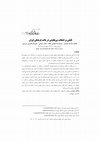
Quarterly of Cultural Studies & Communication, 2012
How do people choose to be apathetic while confronting unfavorable situations? Agents make decisi... more How do people choose to be apathetic while confronting unfavorable situations? Agents make decision about their reaction in the wide range of interactive situations which they experience in their daily lives on the basis of three fundamental factors: personality traits, social position and cultural context. This paper aims at investigating the influence of cultural context on cultural logic as a platform to explain the reasons behind choosing apathy while people confronting unfavorable situations. The study applies Garfinkel and Sikorel's ethno-methodological theories to outline this target.This data has been collected through, semi-structured interviews and reviewing research studies.
referring to the results, agents create social apathy as a social phenomena regarding cultural values and norms which gradually had been formed during their unique background. In the same way, interviewees willingness to act apathetically against unfavorable situations is being made in a united network of cultural context which is shaped by three main elements: “Distinguish”, “Expediency” and “effectiveness”
انسان ها در زندگی روزمرهشان در موقعیتهای تعاملی متعدد و متنوعی قرار میگیرند و در هرکدام از این موقعیتها با پشتِسر گذاشتن فرایندهایی تصمیم میگیرند که چه واکنشی نشان دهند.انتخابِکنشیِ یک کنشگرِ نوعی،در یک موقعیت تعاملی،به سه عامل اصلی یعنی ویژگیهای شخصیتی کنشگر،موقعیتاجتماعی او و پیشینة فرهنگیاش، بستگی دارد.
این مقاله درصدد است تا در چارچوب رویکرد روش شناسی مردم و با استفاده از ابزار مصاحبه عمیق و نیمه ساختاریافته و مطالعات اسنادی، نشان دهد که چگونه زنان و مردان طبقه متوسط ساکن شهر تهران که بین 30 تا 40 سال سن دارند، در زندگی روزمره و در جریان تعاملاتشان با دیگران، تصمیم میگیرند که نسبت به یک وضعیت نامطلوب خاص «بیتفاوت» باشند و نسبت به وضعیت دیگر بی تفاوت نباشند.یافته ها نشان داد که منطق انتخاب بیتفاوتی در میان مصاحبهشوندگان،حول سه مسئلة اصلی یعنی مسئلة تشخیص(حق/باطل)؛ مسئلة مصلحت(بقا/ویرانی) و مسئلة نتیجه(اثربخشی/بیهودگی) صورت بندی میشود.کشف فهم مشترک افراد از هرکدام از این مسائل، مدخلی برای کشف حوزههای تقابل نمادین فرهنگی مؤثر بر انتخاب بیتفاوتی در جامعه مورد مطالعه است.
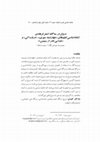
Sociological Journal of Art and Literature جامعه شناسی هنر و ادبیات, 2021
he purpose of this article is to review three films by Asghar Farhadi - "Chaharshanbe Soori", "Ab... more he purpose of this article is to review three films by Asghar Farhadi - "Chaharshanbe Soori", "About Eli" and " Nader’s Separation from Simin" - which deal with the subject of lies. The authors tried to investigate the contexts and functions of falsehood in these three cinematic narratives by using narrative analysis and using semiotic methods and physical codes (technical, social, and ideological codes). The present study, by dividing lies into three types of lies as a loophole, lies as traps and weapons, and lies as Facilitator (facilitator of daily affairs), shows that lies in Farhadi's works originate from urgency and act as an escape route. Meanwhile, the semiotics of the three films show that the Iranian society shown in these works and its requirements for the characters of the three narratives, there is no escape but resorting to lies in the face of various issues.
هدف مقاله پیشرو بررسی سه فیلم از آثار اصغر فرهادی ـ «چهارشنبه سوری»، «درباره الی» و «جدایی نادر از سیمین» ـ است که به موضوع دروغ پرداختهاند. نویسندگان با استفاده از تحلیل روایت و بهرهگیری از روش نشانهشناسی و رمزگان فیسک (رمزگان فنی، اجتماعی و ایدئولوژیک) کوشیدهاند تا زمینهها و کارکردهای دروغ را در این سه روایت سینمایی واکاوی کنند. مطالعه حاضر با تقسیمبندی دروغ به سه نوع دروغ بهمثابه مفّر، دروغ بهعنوان دام و سلاح و دروغ بهعنوان گریس (تسهیلگر امور روزمره)، نشاندهنده آن است که دروغ در آثار فرهادی نشئتگرفته از اضطرار بوده و بهمثابه مفر عمل میکند. در این میان، نشانهشناسی سه فیلم مذکور نشان میدهد که جامعه ایرانی به نمایش درآمده در این آثار و مقتضیات آن برای شخصیتهای سه روایت، در برخورد با مسائل مختلف، راه گریزی جز توسل به دروغ باقی نمیگذارد.
Iranian Journal of Social Problems, 2020
On the base of ethno-methodological approach, this article tried to find the common patterns that... more On the base of ethno-methodological approach, this article tried to find the common patterns that middle class followed during thinking and making decision to separate from their spouse. interviewing with 9 men and 9 women living in Tehran, demonstrated that separation is an identical issue for them.they have made decision to get a divorce only after reviewing three significant parts of their life: period of thinking about marriage, period of marital life and finally when they determined to get a divorce.after this three review, it concluded that the cost of remaining in that kind of marital life is much more than the cultural and psychological cost of a divorce.
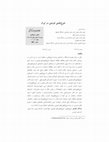
مطالعات جامعه شناختی, 2019
Abstract
Witness and humor is an important aspect of a culture. So, present assay aims to study t... more Abstract
Witness and humor is an important aspect of a culture. So, present assay aims to study the history of ethnic humor in Iran and its diverse types in order to provide a sociological explanation about social- historical origins of the diverse range of ethnic humor in Iran. We try to answer the research questions using the method of “documentary study”. Results show that there has always been diverse kinds of humor with minority groups and individuals, as well as residents of different cities and ethnicities in Iranian culture. In other words, ethnic humor in Iranian society has enjoyed a great deal of variation both in form and in content. Secondly, Ethnic humor has found in the Persian literature in literary genres (Shahr-ashoob, Karnameh-saraii, Mixed humor, and playing with dialects), and in the field of traditional shows and dramas (such as marionette, siah-bazi, and Kabuli-box). In addition, Arabs, Turks, villagers, and residents of different cities of the country have been ridiculed by poets and authors as the target group or the subject of ethnic humor. Finally, the sociological explanation of the findings is carried out through Davies’ theory of ethnic humor and stupid stories.
قاسمی، وحید و محمدرضا جوادی یگانه و فاطمه نصر اصفهانی (۱۳۹۸) «شوخ طبعی های قومیتی در ایران» مجله مطالعات جامعه شناختی. دوره ۲۶. شماره یک. بهار و تابستان ۱۳۹۸. صص ۱۶۹-۱۸۹.
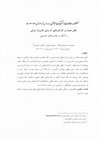
فصلنامه مطالعات و تحقیقات اجتماعی در ایران, 2012
Cell phone is now considered by its users as an entertainment and also a media in addition to ser... more Cell phone is now considered by its users as an entertainment and also a media in addition to serving them as a telecommunication instrument and having a cell phone has more implications for them. In this study, the author has tried to discuss these additional functions and implications through an online survey of a number of cell phone users regardless of its communicational functions The results show that cell phone because of its mobility and continuous accessibility has had functions such as obtaining more security, fashion, self expression, identity, and entertainment in addition to facilitating interpersonal communications.
جوادي يگانه، محمدرضا و مسعود کوثري و طاهره خيرخواه (1391) «تلفن همراه و کارکردهای آن برای کاربران ایرانی با تاکید بر تفاوت های جنسیتی » مجله مطالعات و تحقیقات اجتماعی. (دانشگاه تهران). دوره اول. شماره 2. تابستان 1391. صص 25-55.
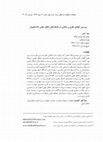
تحقیقات فرهنگی در ایران, 2016
Abstract
This article aims to achieve the theoretical and behavioral preferences on scientific Et... more Abstract
This article aims to achieve the theoretical and behavioral preferences on scientific Ethics norms among PhD students and the level of conformity and unconformity of theoretical and behavioral preferences on scientific Ethics norms among PhD students. It also aims to achieve the realities based on the conflicts and to explain factors related to level of conflict of these values. This article has a combined approach ranging from Ethics theories based on inter- role conflict of Dahrendorf, scientific Ethics indicators of Resnick, Merton, Parsons, Goffman and Ethics Growth theories. Methodology is based on a field survey and its population is PhD students of fields of humanities, engineering and basic sciences from Shahid Beheshti University. One hundred ninety-six students were chosen by complete enumeration method and they were under a test by a questionnaire with total validity 80% and 81% .The results showed there is no complete conformity between theoretical and behavioral preferences on scientific Ethics norms among PhD students so that 16.33 of the students have over 60% conformity and 83.68 of them have over 40% unconformity and The level of unconformity in the theoretical and behavioral preferences on scientific Ethics norms are different in the three fields (among PhD students of fields of humanities, engineering and basic sciences). In addition, when the theoretical preferences -12 Ethics indicators- are considered to each other, there is no conflict among them but in the comparison of the theoretical preferences and behavioral preferences, there is unconformity (conflict) between theoretical and behavioral preferences.
خلفی، شهلا و محمدرضا جوادی یگانه و مهرداد نوابخش (1395) «بررسی انطباق نظری و رفتاری در هنجارهای اخلاق علمی دانشجویان» مجله تحقیقات فرهنگی ایران. دوره 9. شماره 3. پاییز 1395. صص 31-55
ad-minister, 2019
This article uses the game theory, more specifically multiple prisoner’s dilemma game, to analyze... more This article uses the game theory, more specifically multiple prisoner’s dilemma game, to analyze why Iranians refused to give up on receiving public subsidies in April 2014, in spite of frequent requests of the government. Sample of study consists of two main groups: the ones who were not dependent on government subsidy but were applying for it; and the ones who did not depend either but had fraudulently pretended to depend on government subsidy. some suggestions are presented such as to define chicken game and not prisoner’s dilemma game as the main game.
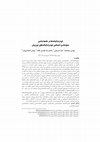
فصلنامه انجمن ایرانی مطالعات فرهنگی و ارتباطات, 2019
Abstract
In this research, we attempted to study hawzavi autobiographies published in Persian lan... more Abstract
In this research, we attempted to study hawzavi autobiographies published in Persian language and extract the neglected and expressed issues in them. Then we aimed to analyze the main themes, central interests and ideas, as well as the present and absent issues of these constructed accounts of the lives of the hawzavis using thematic analysis method. Finally, a sociological typology of these autobiographies is presented based on these data. This typology could be considered as another phase in depicting an image of hawza and its actors as well as their evolution and changes in contemporary Iran.
Findings show that masters, fathers and paternal ancestors are the common expressed issues in most of these autobiographies. Transcendental issues and God are clearly more apparent in the older autobiographies, but they gradually diminish and are depicted in a mediated way, and are finally disappeared in the recent decades. In terms of the presence of women, these autobiographies are divided into two categories of “females-expressed” and “females neglected” and even into two other categories of “economy-expressed” and “economy-neglected”.
Hence, Hawzavi autobiographies are categorized into two general types of “secluded autobiographies” and “social autobiographies”. The presented self in secluded autobiographies is limited to education, worship and a masculine family setting. In contrast, the presented self in social autobiographies is depicted in relation with social issues and a wider network of actors and events; a hawzavi self who is not just hawzavi but a social existence that is ‘also’ hawzavi.
سلیمانیه، مهدی و سارا شریعتی و محمدرضا جوادی یگانه و سیدمهدی اعتمادی فرد (۱۳۹۸) «خودزندگینامه ها در جامعه شناسی: سنخ شناسی اجتماعی خودزندگینامه های حوزویان» فصلنامه انجمن ایرانی مطالعات فرهنگی و ارتباطات. شماره دوره ۱۵،شماره ۵۴. بهار ۱۳۹۸. صص ۱-۱۲.

social welfare quarterly فصلنامه رفاه اجتماعی, 2004
This article investigates the governing ideologies of the third and second plan of Development, b... more This article investigates the governing ideologies of the third and second plan of Development, by using Barrington Moore Jr. (Development program) Theory and also Robert Merton (means and goals) Theory, in order to show the rate of inconsistency between goals and means and ideological conflict in these two plans.
To gain this objectives, first, we explained social, cultural, economic and political principles of socialism and liberalism and then, used the method of content analysis for final goals, policies (middle goals), and provision (means) in these two plans. The results show that in both two plan, mostly the goals were socialistic and the means were often liberalistic. Also the rate of inconsistency between goals and means in the second plan was less than the first plan.
این مقاله با استفاده از نظریه توسعه «برینگتون مور» و نظریه اهداف و وسایل «رابرت مرتون»، به بررسی ایدئولوژیهای حاکم بر برنامه اول و دوم توسعه، برای نشان دادن میزان ناهمخوانی میان اهداف و وسایل و تناقض ایدئولوژیک در این دو برنامه میپردازد. برای این منظور ابتدا اصول سیاسی، اقتصادی، فرهنگی و اجتماعی ایدئولوژیهای لیبرالیسم و سوسیالیسم بیان شده و پس از آن، تحلیل محتوای هدفهای کلی (اهداف غایی)، خط مشیها (اهداف واسط) و تبصرهها (وسایل) در دو برنامه، با روش تمام شماری، انجام شده است. نتایچ نشان میدهند که در دو برنامه، اهداف بیشتر سوسیالیستی و وسایل بیشتر لیبرالیستی بودهاند. همچنین میزان ناهمخوانی بین اهداف و وسایل در برنامه دوم کمتر از برنامه اول بوده است.
جوادي يگانه، محمدرضا (1382) «تناقض ايدئولوژيك در دو برنامه اول و دوم توسعه»، رفاه اجتماعي (8)، تابستان 1382: 120-89.
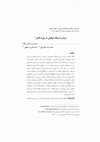
جامعه پژوهی فرهنگی, 2012
Abstract
This paper examines the social morals and customs of Lootian in the Qajar period. Lootia... more Abstract
This paper examines the social morals and customs of Lootian in the Qajar period. Lootian was part of a chain that began with Fotowat and continued through market guild and Ayyari. Although it was transformed in some course, but in the decline, it changed into Lootian and in the present century was changed to Lumpen (in the Marxist theories). There are some different and sometimes conflicting meanings of Lootian, from barefooted and poor, to Pederast. Also Loot in its own language means Satiety. In this article, we explain Lootian’s morals and their difference with Panties and explain attitudes toward Lootian. And specifically, we explain Lootian’s cover and their clothing components, their habitude, Lootian’s languages and dialects, their funs and games, and their names and titles. Finally, rituals of Lootian are discussed and their competitions and fights in Muharram Ceremonies were explained.
جوادی یگانه، محمدرضا، و محمدرضا جعفرآقایی و رضا مختاری اصفهانی (1390) «مرام و مسلک لوطیان در دوره قاجار» جامعه پژوهی فرهنگی. سال دوم، شماره دوم. پاییز و زمستان 1390: 77-99
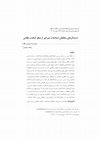
Historical Studies جستارهای تاریخی, 2013
Abstract
Analyzing the arguments of opponents of Amir Kabir’sreforms, the authors of this article... more Abstract
Analyzing the arguments of opponents of Amir Kabir’sreforms, the authors of this article used theRational Choice approach as a general theory in historical sociology to generate acausal narrative to explain the reasons for internal opposition to Amir Kabir’s reforms. For this purpose, the reform opponentswere divided into four groups: clergymen, courtiers, governors, and the women of the Harem. Rational Choice Theory, in which the individual (here the reform opponents) is causal agent, and the instrumental rationality he uses (which here led to their opposition to reforms) is causal mechanism, was used to clarify the rational process of their opposition to reforms. Then, the arguments of the four groups were analyzed, and the first group was omitted based on John Stuart Mill's comparative method. The common arguments were finally recognized using Mill’s method of agreement and methodofconcomitantvariation. They were negligence ofopponents’ position and social class, violation of the citizen's rights, and possible reduction of royal power. These arguments show that the opponents of Amir Kabir's reforms were more concerned with their individual and class benefits.
جوادی یگانه، محمدرضا و ریحانه جوادی (1392) «استدلالهای مخالفان اصلاحات امیرکبیر از منظر انتخاب عقلانی». جستارهای تاریخی. سال چهارم. شماره اول. تابستان 1392. صص 45-77.
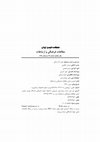
مطالعات فرهنگی و ارتباطات, 2012
Abstract
Development is one of general concepts that have been spoken highly about it. Trying to ... more Abstract
Development is one of general concepts that have been spoken highly about it. Trying to understand indigenous ways of development have been a major concern of Iranian society up to now. Despite these efforts, seems the actor and the subject has been neglected in the development. Not the present or the past history, true and complete story of Iranian economic activists is not available. The only thing is the hegemony of substantial theories that have explained non-development in different ways. Hence, this paper focuses on the Iranian economic characteristic and tries to compare and implement this feature to economic ethic narrated by Max Weber from other religions, particularly Protestant religion. The objective is to achieve the description and explanation of the reason of non- appearance of spirit of capitalism as Weber pointed. The historical period chosen for this study is Naseri’s era up to rise of Reza Khan.
جوادی یگانه، محمدرضا و تقی آزاد ارمکی و سمیه توحیدلو (1391) «فرهنگ و اخلاق اقتصادی ایرانیان در دوره مشروطه» مطالعات فرهنگی و ارتباطات. شماره 29. زمستان 1391. صص 11-40.
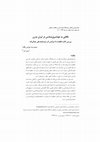
جامعه پژوهی فرهنگی, 2015
Although Seyed Mohammad-Ali Jamal-zadeh is known as one of the three founders of contemporary Ira... more Although Seyed Mohammad-Ali Jamal-zadeh is known as one of the three founders of contemporary Iranian literature in the field of story, it's not the only reason for his fame. He has also published a book named Iranian's Character in 1345 (1966) which has been read and referred much more than any book written in the field of national character, in Iran. In the book, Jamal-zadeh acts like a physician, not a literary man, to diagnose the pain of Iranian society which he calls ‘decay’. But, what is that decay which holds Iran from becoming as developed as the West? Surely it’s people character, Jamal-zadeh says. In short, it is because of our ethic that we are such undeveloped. Fortunately, western travelers, intellectuals and politicians diagnosed those ethics and told us about them. Then, the only thing we should do is admitting our weaknesses and following their instructions.
But this is not the whole story. We ask: what allows Jamal-zadeh to call Iranians with such negative and humiliating accent? Edward Said knows the answer: self-orientalism or self-orientalizing. Publishing Orientalism in late 1970's, Said created a new wave in the post-colonial studies tradition. He believes that Orientalism is not just an academic discipline, but also a discourse facilitating European countries colonization and exploitation over the East. In order to reaching this purpose, Orientalism had to create a new orient which hadn't any relationship with the real one; rather, it was something useful for colonizing purposes. It means that the Euro-centrism governing the orientalists had colonial benefits in developing the Orientalism discourse.
So, this essay aimed to test Jamal-zadeh's Iranian Character against the touchstone of Said's Orientalism and self-Orientalism. We will show that Iranian Character can be considered as a self-orientalizing book.
جوادی یگانه، محمدرضا و آرمین امیر (1394) «نگاهی به خودشرق¬شناسی در ایران مدرن: «خلقیات ما ایرانیان» سیدمحمدعلی جمالزاده» جامعه پژوهی فرهنگی. دوره 4، شماره 4. زمستان 1394. صص 1-19.
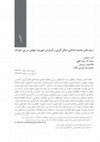
فصلنامه مطالعات راهبردی ورزش و جوانان, 2017
This paper is to investigate the sociological aspects of the formation and developmen... more This paper is to investigate the sociological aspects of the formation and development of global citizenship in young people. The statistical population is all of young students in Islamic Azad University, Science and Research Branch of Tehran that 280 students were selected as statistical sample.In theoretical foundations have been used related theories to this field and at the end of the research theoretical model has been designed. This research has been done using field studies and survey method. The data gathering tool was a researcher made questionnaire and distributed to respondents after validation and reliability estimation. The result shows that there are significant relationship between the experience of globalization, tourism, civil participation, social skills and educational environment, and the formation and expansion of global citizenship as dependent variables.But there are no significant relationship between national media and formation and development of global citizenship. Using the lisrel Structural Equation Model, among all these factors, it was found that social skills, civic participation and globalization experience are three factors that had the greatest impact. It was found that all these three factors: social skills, civil participation and experience are of greatest impact in globalization. But, in the meantime, civil partnership has most influential in formation and expanding the global citizenship of young people.
رشتیانی، آذر و سيف اله سيف اللهي و غلامعباس توسلی و محمدرضا جوادی یگانه (1396) «زمينه های جامعه شناختی شکل گيری و گسترش شهروند جهانی در بين جوانان» .فصلنامه مطالعات راهبردی ورزش و جوانان. شماره 35. بهار 1396. صص 9-28.
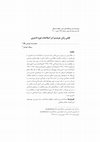
پژوهش نامه زنان, 2012
In the present paper, to analyze the role of Harem women in the reforms of Nasseri’s era, using t... more In the present paper, to analyze the role of Harem women in the reforms of Nasseri’s era, using the rational choice theory as one of the general theories in historical sociology, we described the reasons which these women offered as the cons of the reforms in three reformative period: 1848–1851 (the reforms of Mirza Taqi Khan Amir Kabir); 1859–1862 (the reforms of Nasser al-Din Shah); and 1871–1873 (the reforms of MirzaHossein Khan Sepahsalar). This paper criticized the dominant approach in historical narratives and the analysis that introduce harem women as sexual objects that were simply plaything of the courtiers, governors and clergymen by using their body for seducing. Focusing on two Naser al-Din Shah’s harem women, Mahd-e Olia (1805- 1873) andAnis al-Doleh (1842- 1896), this paper emphasize on the rational choice of this actors and the reasons they are offered to criticize the reforms. This shows that their reasonings are not much different from the other groups who are known as the cons of reforms in Nasseri's era.
جوادی یگانه، محمدرضا و ریحانه جوادی (1391) « درآمدی بر جامعه شناسی تاریخی حرمسرا: نقشِ زنان حرم سرا در اصلاحات دوره ناصری» پژوهش نامه زنان. سال سوم. شماره اول. بهار و تابستان 1391. صص 1-21.
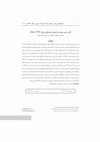
جامعه شناسی هنر و ادبیات, 2013
جوادی یگانه، محمدرضا و بشیر تفنگ سازی (1392) «تاثیر حزب توده در ادبیات داستانی ایران (1332-1357)»... more جوادی یگانه، محمدرضا و بشیر تفنگ سازی (1392) «تاثیر حزب توده در ادبیات داستانی ایران (1332-1357)» جامعه شناسی هنر و ادبیات. دوره پنجم. شماره اول. بهار و تابستان 1392. صص 1-20.
Investigating the Iranian fiction literature during 1953 to 1978, it seems being influenced by a common trend of thought and sane ideas of humbling the rich and adoring the poor. They are all full of critiques to the inequalities in the society, the ruling calls, or in general, the capitalism. Our main hypothesis in this research was that Iranian literature was subjected to Toodeh Party’s interpretation of Marxism. Studding the contemporary history of Iran, we realize that Toodeh Party has been the most organized and popular political party in this country since ever. Reaching the remarkable number of 300 thousand members within the 40s, we can assume how influential this party has been in this society. Our hypothesis grows stronger when we notice that almost every Iranian writer and intellectual in that era has been a member or at least fan of this party. But, what was the interpretation of Marxism this political party relied on? Here, we come to the other hypothesis of this article. We believe that Toodeh Party had applied the interpretation of Marxism dominant in the Soviet Union at that time, which has used to be called Leninism. In order to testify our hypothesis, we first drew ideal types of the characteristics of the interpretation of Leninism and then Toodeh Party. Comparing them we realized that they had two points in common out of three (which are revision in Marx’s ideas to legitimate the revolution in unindustrialized countries and authoritarian structure of the party which did not allow the members to stand against the ideas of the heads.). Thus, we concluded that this hypothesis has been fairly verified. To assess the second hypothesis, we decided to investigate through a sample of Persian stories, written by the most influential writers of that era, in order to distinguish ideas associated with Marxism in them (such as critiques against the rich and inequalities in wealth, hostility to the capitalist word and so on). Meanwhile we provided a succinct biography of the writer of these books too, to indicate the potential reasons of their sympathy for Toodeh party. This hypothesis was verified too by discerning a reasonable account of such ideas in the books. Finally, we can claim that Iranian prose literature in the studied era has been considerably subject to Marxist ideas, which were represented in Iran by Toodeh party, a political party which had been following the Leninist trend of Marxism in Iran.
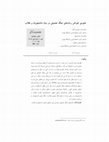
مطالعات جامعه شناختی, 2013
جوادی یگانه، محمدرضا و غلامرضا جمشیدیها و سیدمحمدعلی صحفی (1392) «نحوه خوانش رمان های جنگ تحمیلی ... more جوادی یگانه، محمدرضا و غلامرضا جمشیدیها و سیدمحمدعلی صحفی (1392) «نحوه خوانش رمان های جنگ تحمیلی در میان دانشجویان و طلاب» مطالعات جامعه شناختی (نامه علوم اجتماعی). دوره 20. شماره 1. بهار و تابستان 1392. صص 67-94.
Abstract
Inrecent decades literary theory doesn’t limit itself to the text or the author, and pays attention to the readers and the quality of their understanding of a literary text. Now, the reader as an active audience in understanding of a literary text has taken a role in the creation of a work by an author. This point is observable in the reading of literary works written about the Iraqi war against Iran. Since these works intend to transfer the post-war values to the next generation, so the reader understanding of those works can be considered very important.
Using the views of thinkers such as Wolfgang Iser, Stanley Fish and Julia Kristeva, this paper intends to reach the understanding of the readers of imposed war novels. For this purpose, using a qualitative analysis of the content of the mentioned novels and doing deep interviews, we have conducted a research among two groups of university and religious schools students. The results show that there is a difference between two groups of students in some respects such as the spiritual view of the students of religious schools and the worldly views of the students of universities towards these types of novels.
تاریخ ایرانی, 2019
درباره نسلی که میخواهد انقلاب اسلامی و حضورش در آن را فراموش کند و فراموشش کنند
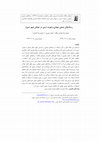
جامعه شناسی نهادهای اجتماعی, 2014
جوادي يگانه، محمدرضا و جليل عزيزي و محمدرضا انصاری (1392) «رسانه هاي جمعي و هويت ديني در جوانان ش... more جوادي يگانه، محمدرضا و جليل عزيزي و محمدرضا انصاری (1392) «رسانه هاي جمعي و هويت ديني در جوانان شهر شيراز» جامعه شناسی نهادهای اجتماعی (دانشگاه مازندران). دوره اول. شماره اول. صص 83-102.
The current article studies the influence of mass media on religious identity of young people of Shiraz. The breadth and depth of the soft power of media has caused the prevalence of expressions such as global village and globalization of culture in the social, cultural and media literature in various societies. Belonging to identity elements is one of the most affected areas in the sphere of mass media activities. This article is the result of empirical research in this area and wants to investigate the effects of global mass media (satellite TV’s and internet) on belonging to the religious identity of the youth. In other words, the main question is whether the use of global mass media effects the youth with religious background. And if the answer is yes, what are the influential mechanisms? To answer these questions, after reviewing the literature, causal models include mechanism variables, was constructed. The population of this study comprised students in the third year of high school in Shiraz. The method used in this research was survey and validity of variables measured by formal validity and variables reliability measured by Cronbach's alpha. The statistical hypothesis testing used in this article included Pearsons correlation, ANOVA, multivariable regression and path analysis. Correlation analysis showed a negative significant relation between the amount of international mass media use and religious identity.
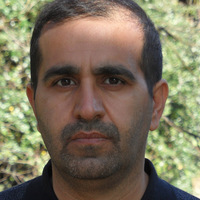
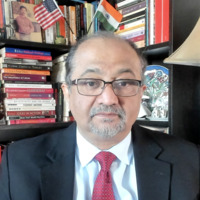









Uploads
PAPERS مقالات by M. R. Javadi Yeganeh
Method: In this article, using a quasi-experimental method with a one-group pretest and posttest design, the issue of historical literacy of students in a class about the important historical issues of Iran, including the fall of the Safavid dynasty, the Treaty of Turkmenchai, and the construction of the national South-North railroad, was investigated and analyzed. The studied population of this research is the students of the course on Iranian social history of undergraduate studies at the Faculty of Social Sciences of the University of Tehran.
Finding: The results of the research show that the students’ familiarity with different historical sources and the students’ historical literacy are different in relation to the mentioned important events. One of the results is the difference in students’ views about the Turkmenchai Treaty. In the pretest, most of them thought this treaty was a shameful treaty, but in the posttest, they found a more benevolent attitude towards this treaty.
Conclusion: The study of students’ responses showed that by using panel research to promote students’ historical literacy at the end of the semester, students’ performance in historical empathy and historically fair judgment improved.
در جامعۀ جدید سواد نقش مهمی در تبدیل افراد به شهروندان فعال اجتماعی دارد. توانایی خواندن و نوشتن به این معناست که فرد بتواند با رویدادهای جاری همگام باشد، ارتباط مؤثر داشته باشد و مسائلی جهان را درک کند. با گذشت زمان و پیشرفت زندگی، دیگر سواد به معنای توانایی خواندن یک کلمه نیست، بلکه به معنای توانایی درک دنیاست. سواد تاریخی نهتنها یادگیری رخدادهای تاریخی را دربردارد، بلکه تقویت توانایی استدلالپذیری روایتهای تفسیری تاریخی را در اولویت قرار میدهد تا بتواند سواد علمی افراد جامعه را پرورش دهد. افراد برای آنکه بتوانند حال و آینده را در بستر گذشته ببینند، باید دو مهارت داشته باشند: درک تاریخ بهمنزلۀ علم و یافتن چارچوبی قابلاستفاده از گذشته. سواد تاریخی این چارچوب است، به کمک بازآموزی تاریخی میآید و با ایجاد توازنی عادلانه در روند آموزش تاریخی میان انتظارات جامعه از آموزش آن، با اطلاعات، توان و آگاهی افراد، بهمنزلۀ هدف نهایی به توسعۀ حافظۀ تاریخی افراد منجر میشود. در مقالۀ حاضر با استفاده از روش پانل طولی، موضوع سواد تاریخی دانشجویان یک کلاس دربارۀ مسائل مهم تاریخی ایران، شامل سقوط صفویه، عهدنامۀ ترکمنچای و تأسیس راهآهن سراسری جنوب به شمال، بررسی و تحلیل شده است. جامعۀ مورد بررسی این تحقیق دانشجویان درس مبانی تاریخ اجتماعی ایران دورۀ کارشناسی دانشکدۀ علوم اجتماعی دانشگاه تهران هستند. یافتههای تحقیق بیانکنندۀ تأثیر محرکهای مانند آشنایی دانشجویان با منابع مختلف تاریخی است. همچنین سواد تاریخی دانشجویان دربارۀ رویدادهای مهم ذکرشده، متفاوت است. یکی از یافتهها تفاوت دیدگاه دانشجویان دربارۀ عهدنامۀ ترکمنچای است. بیشتر آنها در پیشآزمون این عهدنامه را ننگین میدانستند، اما در پسآزمون تلقی همدلانهتری به این عهدنامه داشتند. بررسی پاسخهای دانشجویان نشان میدهد با استفاده از تحقیقات پانل برای افزایش سواد تاریخی دانشجویان، در انتهای ترم، عملکرد دانشجویان در همدلی تاریخی و قضاوت منصفانه تاریخی بهبود یافت.
referring to the results, agents create social apathy as a social phenomena regarding cultural values and norms which gradually had been formed during their unique background. In the same way, interviewees willingness to act apathetically against unfavorable situations is being made in a united network of cultural context which is shaped by three main elements: “Distinguish”, “Expediency” and “effectiveness”
انسان ها در زندگی روزمرهشان در موقعیتهای تعاملی متعدد و متنوعی قرار میگیرند و در هرکدام از این موقعیتها با پشتِسر گذاشتن فرایندهایی تصمیم میگیرند که چه واکنشی نشان دهند.انتخابِکنشیِ یک کنشگرِ نوعی،در یک موقعیت تعاملی،به سه عامل اصلی یعنی ویژگیهای شخصیتی کنشگر،موقعیتاجتماعی او و پیشینة فرهنگیاش، بستگی دارد.
این مقاله درصدد است تا در چارچوب رویکرد روش شناسی مردم و با استفاده از ابزار مصاحبه عمیق و نیمه ساختاریافته و مطالعات اسنادی، نشان دهد که چگونه زنان و مردان طبقه متوسط ساکن شهر تهران که بین 30 تا 40 سال سن دارند، در زندگی روزمره و در جریان تعاملاتشان با دیگران، تصمیم میگیرند که نسبت به یک وضعیت نامطلوب خاص «بیتفاوت» باشند و نسبت به وضعیت دیگر بی تفاوت نباشند.یافته ها نشان داد که منطق انتخاب بیتفاوتی در میان مصاحبهشوندگان،حول سه مسئلة اصلی یعنی مسئلة تشخیص(حق/باطل)؛ مسئلة مصلحت(بقا/ویرانی) و مسئلة نتیجه(اثربخشی/بیهودگی) صورت بندی میشود.کشف فهم مشترک افراد از هرکدام از این مسائل، مدخلی برای کشف حوزههای تقابل نمادین فرهنگی مؤثر بر انتخاب بیتفاوتی در جامعه مورد مطالعه است.
هدف مقاله پیشرو بررسی سه فیلم از آثار اصغر فرهادی ـ «چهارشنبه سوری»، «درباره الی» و «جدایی نادر از سیمین» ـ است که به موضوع دروغ پرداختهاند. نویسندگان با استفاده از تحلیل روایت و بهرهگیری از روش نشانهشناسی و رمزگان فیسک (رمزگان فنی، اجتماعی و ایدئولوژیک) کوشیدهاند تا زمینهها و کارکردهای دروغ را در این سه روایت سینمایی واکاوی کنند. مطالعه حاضر با تقسیمبندی دروغ به سه نوع دروغ بهمثابه مفّر، دروغ بهعنوان دام و سلاح و دروغ بهعنوان گریس (تسهیلگر امور روزمره)، نشاندهنده آن است که دروغ در آثار فرهادی نشئتگرفته از اضطرار بوده و بهمثابه مفر عمل میکند. در این میان، نشانهشناسی سه فیلم مذکور نشان میدهد که جامعه ایرانی به نمایش درآمده در این آثار و مقتضیات آن برای شخصیتهای سه روایت، در برخورد با مسائل مختلف، راه گریزی جز توسل به دروغ باقی نمیگذارد.
Witness and humor is an important aspect of a culture. So, present assay aims to study the history of ethnic humor in Iran and its diverse types in order to provide a sociological explanation about social- historical origins of the diverse range of ethnic humor in Iran. We try to answer the research questions using the method of “documentary study”. Results show that there has always been diverse kinds of humor with minority groups and individuals, as well as residents of different cities and ethnicities in Iranian culture. In other words, ethnic humor in Iranian society has enjoyed a great deal of variation both in form and in content. Secondly, Ethnic humor has found in the Persian literature in literary genres (Shahr-ashoob, Karnameh-saraii, Mixed humor, and playing with dialects), and in the field of traditional shows and dramas (such as marionette, siah-bazi, and Kabuli-box). In addition, Arabs, Turks, villagers, and residents of different cities of the country have been ridiculed by poets and authors as the target group or the subject of ethnic humor. Finally, the sociological explanation of the findings is carried out through Davies’ theory of ethnic humor and stupid stories.
قاسمی، وحید و محمدرضا جوادی یگانه و فاطمه نصر اصفهانی (۱۳۹۸) «شوخ طبعی های قومیتی در ایران» مجله مطالعات جامعه شناختی. دوره ۲۶. شماره یک. بهار و تابستان ۱۳۹۸. صص ۱۶۹-۱۸۹.
جوادي يگانه، محمدرضا و مسعود کوثري و طاهره خيرخواه (1391) «تلفن همراه و کارکردهای آن برای کاربران ایرانی با تاکید بر تفاوت های جنسیتی » مجله مطالعات و تحقیقات اجتماعی. (دانشگاه تهران). دوره اول. شماره 2. تابستان 1391. صص 25-55.
This article aims to achieve the theoretical and behavioral preferences on scientific Ethics norms among PhD students and the level of conformity and unconformity of theoretical and behavioral preferences on scientific Ethics norms among PhD students. It also aims to achieve the realities based on the conflicts and to explain factors related to level of conflict of these values. This article has a combined approach ranging from Ethics theories based on inter- role conflict of Dahrendorf, scientific Ethics indicators of Resnick, Merton, Parsons, Goffman and Ethics Growth theories. Methodology is based on a field survey and its population is PhD students of fields of humanities, engineering and basic sciences from Shahid Beheshti University. One hundred ninety-six students were chosen by complete enumeration method and they were under a test by a questionnaire with total validity 80% and 81% .The results showed there is no complete conformity between theoretical and behavioral preferences on scientific Ethics norms among PhD students so that 16.33 of the students have over 60% conformity and 83.68 of them have over 40% unconformity and The level of unconformity in the theoretical and behavioral preferences on scientific Ethics norms are different in the three fields (among PhD students of fields of humanities, engineering and basic sciences). In addition, when the theoretical preferences -12 Ethics indicators- are considered to each other, there is no conflict among them but in the comparison of the theoretical preferences and behavioral preferences, there is unconformity (conflict) between theoretical and behavioral preferences.
خلفی، شهلا و محمدرضا جوادی یگانه و مهرداد نوابخش (1395) «بررسی انطباق نظری و رفتاری در هنجارهای اخلاق علمی دانشجویان» مجله تحقیقات فرهنگی ایران. دوره 9. شماره 3. پاییز 1395. صص 31-55
In this research, we attempted to study hawzavi autobiographies published in Persian language and extract the neglected and expressed issues in them. Then we aimed to analyze the main themes, central interests and ideas, as well as the present and absent issues of these constructed accounts of the lives of the hawzavis using thematic analysis method. Finally, a sociological typology of these autobiographies is presented based on these data. This typology could be considered as another phase in depicting an image of hawza and its actors as well as their evolution and changes in contemporary Iran.
Findings show that masters, fathers and paternal ancestors are the common expressed issues in most of these autobiographies. Transcendental issues and God are clearly more apparent in the older autobiographies, but they gradually diminish and are depicted in a mediated way, and are finally disappeared in the recent decades. In terms of the presence of women, these autobiographies are divided into two categories of “females-expressed” and “females neglected” and even into two other categories of “economy-expressed” and “economy-neglected”.
Hence, Hawzavi autobiographies are categorized into two general types of “secluded autobiographies” and “social autobiographies”. The presented self in secluded autobiographies is limited to education, worship and a masculine family setting. In contrast, the presented self in social autobiographies is depicted in relation with social issues and a wider network of actors and events; a hawzavi self who is not just hawzavi but a social existence that is ‘also’ hawzavi.
سلیمانیه، مهدی و سارا شریعتی و محمدرضا جوادی یگانه و سیدمهدی اعتمادی فرد (۱۳۹۸) «خودزندگینامه ها در جامعه شناسی: سنخ شناسی اجتماعی خودزندگینامه های حوزویان» فصلنامه انجمن ایرانی مطالعات فرهنگی و ارتباطات. شماره دوره ۱۵،شماره ۵۴. بهار ۱۳۹۸. صص ۱-۱۲.
To gain this objectives, first, we explained social, cultural, economic and political principles of socialism and liberalism and then, used the method of content analysis for final goals, policies (middle goals), and provision (means) in these two plans. The results show that in both two plan, mostly the goals were socialistic and the means were often liberalistic. Also the rate of inconsistency between goals and means in the second plan was less than the first plan.
این مقاله با استفاده از نظریه توسعه «برینگتون مور» و نظریه اهداف و وسایل «رابرت مرتون»، به بررسی ایدئولوژیهای حاکم بر برنامه اول و دوم توسعه، برای نشان دادن میزان ناهمخوانی میان اهداف و وسایل و تناقض ایدئولوژیک در این دو برنامه میپردازد. برای این منظور ابتدا اصول سیاسی، اقتصادی، فرهنگی و اجتماعی ایدئولوژیهای لیبرالیسم و سوسیالیسم بیان شده و پس از آن، تحلیل محتوای هدفهای کلی (اهداف غایی)، خط مشیها (اهداف واسط) و تبصرهها (وسایل) در دو برنامه، با روش تمام شماری، انجام شده است. نتایچ نشان میدهند که در دو برنامه، اهداف بیشتر سوسیالیستی و وسایل بیشتر لیبرالیستی بودهاند. همچنین میزان ناهمخوانی بین اهداف و وسایل در برنامه دوم کمتر از برنامه اول بوده است.
جوادي يگانه، محمدرضا (1382) «تناقض ايدئولوژيك در دو برنامه اول و دوم توسعه»، رفاه اجتماعي (8)، تابستان 1382: 120-89.
This paper examines the social morals and customs of Lootian in the Qajar period. Lootian was part of a chain that began with Fotowat and continued through market guild and Ayyari. Although it was transformed in some course, but in the decline, it changed into Lootian and in the present century was changed to Lumpen (in the Marxist theories). There are some different and sometimes conflicting meanings of Lootian, from barefooted and poor, to Pederast. Also Loot in its own language means Satiety. In this article, we explain Lootian’s morals and their difference with Panties and explain attitudes toward Lootian. And specifically, we explain Lootian’s cover and their clothing components, their habitude, Lootian’s languages and dialects, their funs and games, and their names and titles. Finally, rituals of Lootian are discussed and their competitions and fights in Muharram Ceremonies were explained.
جوادی یگانه، محمدرضا، و محمدرضا جعفرآقایی و رضا مختاری اصفهانی (1390) «مرام و مسلک لوطیان در دوره قاجار» جامعه پژوهی فرهنگی. سال دوم، شماره دوم. پاییز و زمستان 1390: 77-99
Analyzing the arguments of opponents of Amir Kabir’sreforms, the authors of this article used theRational Choice approach as a general theory in historical sociology to generate acausal narrative to explain the reasons for internal opposition to Amir Kabir’s reforms. For this purpose, the reform opponentswere divided into four groups: clergymen, courtiers, governors, and the women of the Harem. Rational Choice Theory, in which the individual (here the reform opponents) is causal agent, and the instrumental rationality he uses (which here led to their opposition to reforms) is causal mechanism, was used to clarify the rational process of their opposition to reforms. Then, the arguments of the four groups were analyzed, and the first group was omitted based on John Stuart Mill's comparative method. The common arguments were finally recognized using Mill’s method of agreement and methodofconcomitantvariation. They were negligence ofopponents’ position and social class, violation of the citizen's rights, and possible reduction of royal power. These arguments show that the opponents of Amir Kabir's reforms were more concerned with their individual and class benefits.
جوادی یگانه، محمدرضا و ریحانه جوادی (1392) «استدلالهای مخالفان اصلاحات امیرکبیر از منظر انتخاب عقلانی». جستارهای تاریخی. سال چهارم. شماره اول. تابستان 1392. صص 45-77.
Development is one of general concepts that have been spoken highly about it. Trying to understand indigenous ways of development have been a major concern of Iranian society up to now. Despite these efforts, seems the actor and the subject has been neglected in the development. Not the present or the past history, true and complete story of Iranian economic activists is not available. The only thing is the hegemony of substantial theories that have explained non-development in different ways. Hence, this paper focuses on the Iranian economic characteristic and tries to compare and implement this feature to economic ethic narrated by Max Weber from other religions, particularly Protestant religion. The objective is to achieve the description and explanation of the reason of non- appearance of spirit of capitalism as Weber pointed. The historical period chosen for this study is Naseri’s era up to rise of Reza Khan.
جوادی یگانه، محمدرضا و تقی آزاد ارمکی و سمیه توحیدلو (1391) «فرهنگ و اخلاق اقتصادی ایرانیان در دوره مشروطه» مطالعات فرهنگی و ارتباطات. شماره 29. زمستان 1391. صص 11-40.
But this is not the whole story. We ask: what allows Jamal-zadeh to call Iranians with such negative and humiliating accent? Edward Said knows the answer: self-orientalism or self-orientalizing. Publishing Orientalism in late 1970's, Said created a new wave in the post-colonial studies tradition. He believes that Orientalism is not just an academic discipline, but also a discourse facilitating European countries colonization and exploitation over the East. In order to reaching this purpose, Orientalism had to create a new orient which hadn't any relationship with the real one; rather, it was something useful for colonizing purposes. It means that the Euro-centrism governing the orientalists had colonial benefits in developing the Orientalism discourse.
So, this essay aimed to test Jamal-zadeh's Iranian Character against the touchstone of Said's Orientalism and self-Orientalism. We will show that Iranian Character can be considered as a self-orientalizing book.
جوادی یگانه، محمدرضا و آرمین امیر (1394) «نگاهی به خودشرق¬شناسی در ایران مدرن: «خلقیات ما ایرانیان» سیدمحمدعلی جمالزاده» جامعه پژوهی فرهنگی. دوره 4، شماره 4. زمستان 1394. صص 1-19.
رشتیانی، آذر و سيف اله سيف اللهي و غلامعباس توسلی و محمدرضا جوادی یگانه (1396) «زمينه های جامعه شناختی شکل گيری و گسترش شهروند جهانی در بين جوانان» .فصلنامه مطالعات راهبردی ورزش و جوانان. شماره 35. بهار 1396. صص 9-28.
جوادی یگانه، محمدرضا و ریحانه جوادی (1391) « درآمدی بر جامعه شناسی تاریخی حرمسرا: نقشِ زنان حرم سرا در اصلاحات دوره ناصری» پژوهش نامه زنان. سال سوم. شماره اول. بهار و تابستان 1391. صص 1-21.
Investigating the Iranian fiction literature during 1953 to 1978, it seems being influenced by a common trend of thought and sane ideas of humbling the rich and adoring the poor. They are all full of critiques to the inequalities in the society, the ruling calls, or in general, the capitalism. Our main hypothesis in this research was that Iranian literature was subjected to Toodeh Party’s interpretation of Marxism. Studding the contemporary history of Iran, we realize that Toodeh Party has been the most organized and popular political party in this country since ever. Reaching the remarkable number of 300 thousand members within the 40s, we can assume how influential this party has been in this society. Our hypothesis grows stronger when we notice that almost every Iranian writer and intellectual in that era has been a member or at least fan of this party. But, what was the interpretation of Marxism this political party relied on? Here, we come to the other hypothesis of this article. We believe that Toodeh Party had applied the interpretation of Marxism dominant in the Soviet Union at that time, which has used to be called Leninism. In order to testify our hypothesis, we first drew ideal types of the characteristics of the interpretation of Leninism and then Toodeh Party. Comparing them we realized that they had two points in common out of three (which are revision in Marx’s ideas to legitimate the revolution in unindustrialized countries and authoritarian structure of the party which did not allow the members to stand against the ideas of the heads.). Thus, we concluded that this hypothesis has been fairly verified. To assess the second hypothesis, we decided to investigate through a sample of Persian stories, written by the most influential writers of that era, in order to distinguish ideas associated with Marxism in them (such as critiques against the rich and inequalities in wealth, hostility to the capitalist word and so on). Meanwhile we provided a succinct biography of the writer of these books too, to indicate the potential reasons of their sympathy for Toodeh party. This hypothesis was verified too by discerning a reasonable account of such ideas in the books. Finally, we can claim that Iranian prose literature in the studied era has been considerably subject to Marxist ideas, which were represented in Iran by Toodeh party, a political party which had been following the Leninist trend of Marxism in Iran.
Abstract
Inrecent decades literary theory doesn’t limit itself to the text or the author, and pays attention to the readers and the quality of their understanding of a literary text. Now, the reader as an active audience in understanding of a literary text has taken a role in the creation of a work by an author. This point is observable in the reading of literary works written about the Iraqi war against Iran. Since these works intend to transfer the post-war values to the next generation, so the reader understanding of those works can be considered very important.
Using the views of thinkers such as Wolfgang Iser, Stanley Fish and Julia Kristeva, this paper intends to reach the understanding of the readers of imposed war novels. For this purpose, using a qualitative analysis of the content of the mentioned novels and doing deep interviews, we have conducted a research among two groups of university and religious schools students. The results show that there is a difference between two groups of students in some respects such as the spiritual view of the students of religious schools and the worldly views of the students of universities towards these types of novels.
The current article studies the influence of mass media on religious identity of young people of Shiraz. The breadth and depth of the soft power of media has caused the prevalence of expressions such as global village and globalization of culture in the social, cultural and media literature in various societies. Belonging to identity elements is one of the most affected areas in the sphere of mass media activities. This article is the result of empirical research in this area and wants to investigate the effects of global mass media (satellite TV’s and internet) on belonging to the religious identity of the youth. In other words, the main question is whether the use of global mass media effects the youth with religious background. And if the answer is yes, what are the influential mechanisms? To answer these questions, after reviewing the literature, causal models include mechanism variables, was constructed. The population of this study comprised students in the third year of high school in Shiraz. The method used in this research was survey and validity of variables measured by formal validity and variables reliability measured by Cronbach's alpha. The statistical hypothesis testing used in this article included Pearsons correlation, ANOVA, multivariable regression and path analysis. Correlation analysis showed a negative significant relation between the amount of international mass media use and religious identity.
Method: In this article, using a quasi-experimental method with a one-group pretest and posttest design, the issue of historical literacy of students in a class about the important historical issues of Iran, including the fall of the Safavid dynasty, the Treaty of Turkmenchai, and the construction of the national South-North railroad, was investigated and analyzed. The studied population of this research is the students of the course on Iranian social history of undergraduate studies at the Faculty of Social Sciences of the University of Tehran.
Finding: The results of the research show that the students’ familiarity with different historical sources and the students’ historical literacy are different in relation to the mentioned important events. One of the results is the difference in students’ views about the Turkmenchai Treaty. In the pretest, most of them thought this treaty was a shameful treaty, but in the posttest, they found a more benevolent attitude towards this treaty.
Conclusion: The study of students’ responses showed that by using panel research to promote students’ historical literacy at the end of the semester, students’ performance in historical empathy and historically fair judgment improved.
در جامعۀ جدید سواد نقش مهمی در تبدیل افراد به شهروندان فعال اجتماعی دارد. توانایی خواندن و نوشتن به این معناست که فرد بتواند با رویدادهای جاری همگام باشد، ارتباط مؤثر داشته باشد و مسائلی جهان را درک کند. با گذشت زمان و پیشرفت زندگی، دیگر سواد به معنای توانایی خواندن یک کلمه نیست، بلکه به معنای توانایی درک دنیاست. سواد تاریخی نهتنها یادگیری رخدادهای تاریخی را دربردارد، بلکه تقویت توانایی استدلالپذیری روایتهای تفسیری تاریخی را در اولویت قرار میدهد تا بتواند سواد علمی افراد جامعه را پرورش دهد. افراد برای آنکه بتوانند حال و آینده را در بستر گذشته ببینند، باید دو مهارت داشته باشند: درک تاریخ بهمنزلۀ علم و یافتن چارچوبی قابلاستفاده از گذشته. سواد تاریخی این چارچوب است، به کمک بازآموزی تاریخی میآید و با ایجاد توازنی عادلانه در روند آموزش تاریخی میان انتظارات جامعه از آموزش آن، با اطلاعات، توان و آگاهی افراد، بهمنزلۀ هدف نهایی به توسعۀ حافظۀ تاریخی افراد منجر میشود. در مقالۀ حاضر با استفاده از روش پانل طولی، موضوع سواد تاریخی دانشجویان یک کلاس دربارۀ مسائل مهم تاریخی ایران، شامل سقوط صفویه، عهدنامۀ ترکمنچای و تأسیس راهآهن سراسری جنوب به شمال، بررسی و تحلیل شده است. جامعۀ مورد بررسی این تحقیق دانشجویان درس مبانی تاریخ اجتماعی ایران دورۀ کارشناسی دانشکدۀ علوم اجتماعی دانشگاه تهران هستند. یافتههای تحقیق بیانکنندۀ تأثیر محرکهای مانند آشنایی دانشجویان با منابع مختلف تاریخی است. همچنین سواد تاریخی دانشجویان دربارۀ رویدادهای مهم ذکرشده، متفاوت است. یکی از یافتهها تفاوت دیدگاه دانشجویان دربارۀ عهدنامۀ ترکمنچای است. بیشتر آنها در پیشآزمون این عهدنامه را ننگین میدانستند، اما در پسآزمون تلقی همدلانهتری به این عهدنامه داشتند. بررسی پاسخهای دانشجویان نشان میدهد با استفاده از تحقیقات پانل برای افزایش سواد تاریخی دانشجویان، در انتهای ترم، عملکرد دانشجویان در همدلی تاریخی و قضاوت منصفانه تاریخی بهبود یافت.
referring to the results, agents create social apathy as a social phenomena regarding cultural values and norms which gradually had been formed during their unique background. In the same way, interviewees willingness to act apathetically against unfavorable situations is being made in a united network of cultural context which is shaped by three main elements: “Distinguish”, “Expediency” and “effectiveness”
انسان ها در زندگی روزمرهشان در موقعیتهای تعاملی متعدد و متنوعی قرار میگیرند و در هرکدام از این موقعیتها با پشتِسر گذاشتن فرایندهایی تصمیم میگیرند که چه واکنشی نشان دهند.انتخابِکنشیِ یک کنشگرِ نوعی،در یک موقعیت تعاملی،به سه عامل اصلی یعنی ویژگیهای شخصیتی کنشگر،موقعیتاجتماعی او و پیشینة فرهنگیاش، بستگی دارد.
این مقاله درصدد است تا در چارچوب رویکرد روش شناسی مردم و با استفاده از ابزار مصاحبه عمیق و نیمه ساختاریافته و مطالعات اسنادی، نشان دهد که چگونه زنان و مردان طبقه متوسط ساکن شهر تهران که بین 30 تا 40 سال سن دارند، در زندگی روزمره و در جریان تعاملاتشان با دیگران، تصمیم میگیرند که نسبت به یک وضعیت نامطلوب خاص «بیتفاوت» باشند و نسبت به وضعیت دیگر بی تفاوت نباشند.یافته ها نشان داد که منطق انتخاب بیتفاوتی در میان مصاحبهشوندگان،حول سه مسئلة اصلی یعنی مسئلة تشخیص(حق/باطل)؛ مسئلة مصلحت(بقا/ویرانی) و مسئلة نتیجه(اثربخشی/بیهودگی) صورت بندی میشود.کشف فهم مشترک افراد از هرکدام از این مسائل، مدخلی برای کشف حوزههای تقابل نمادین فرهنگی مؤثر بر انتخاب بیتفاوتی در جامعه مورد مطالعه است.
هدف مقاله پیشرو بررسی سه فیلم از آثار اصغر فرهادی ـ «چهارشنبه سوری»، «درباره الی» و «جدایی نادر از سیمین» ـ است که به موضوع دروغ پرداختهاند. نویسندگان با استفاده از تحلیل روایت و بهرهگیری از روش نشانهشناسی و رمزگان فیسک (رمزگان فنی، اجتماعی و ایدئولوژیک) کوشیدهاند تا زمینهها و کارکردهای دروغ را در این سه روایت سینمایی واکاوی کنند. مطالعه حاضر با تقسیمبندی دروغ به سه نوع دروغ بهمثابه مفّر، دروغ بهعنوان دام و سلاح و دروغ بهعنوان گریس (تسهیلگر امور روزمره)، نشاندهنده آن است که دروغ در آثار فرهادی نشئتگرفته از اضطرار بوده و بهمثابه مفر عمل میکند. در این میان، نشانهشناسی سه فیلم مذکور نشان میدهد که جامعه ایرانی به نمایش درآمده در این آثار و مقتضیات آن برای شخصیتهای سه روایت، در برخورد با مسائل مختلف، راه گریزی جز توسل به دروغ باقی نمیگذارد.
Witness and humor is an important aspect of a culture. So, present assay aims to study the history of ethnic humor in Iran and its diverse types in order to provide a sociological explanation about social- historical origins of the diverse range of ethnic humor in Iran. We try to answer the research questions using the method of “documentary study”. Results show that there has always been diverse kinds of humor with minority groups and individuals, as well as residents of different cities and ethnicities in Iranian culture. In other words, ethnic humor in Iranian society has enjoyed a great deal of variation both in form and in content. Secondly, Ethnic humor has found in the Persian literature in literary genres (Shahr-ashoob, Karnameh-saraii, Mixed humor, and playing with dialects), and in the field of traditional shows and dramas (such as marionette, siah-bazi, and Kabuli-box). In addition, Arabs, Turks, villagers, and residents of different cities of the country have been ridiculed by poets and authors as the target group or the subject of ethnic humor. Finally, the sociological explanation of the findings is carried out through Davies’ theory of ethnic humor and stupid stories.
قاسمی، وحید و محمدرضا جوادی یگانه و فاطمه نصر اصفهانی (۱۳۹۸) «شوخ طبعی های قومیتی در ایران» مجله مطالعات جامعه شناختی. دوره ۲۶. شماره یک. بهار و تابستان ۱۳۹۸. صص ۱۶۹-۱۸۹.
جوادي يگانه، محمدرضا و مسعود کوثري و طاهره خيرخواه (1391) «تلفن همراه و کارکردهای آن برای کاربران ایرانی با تاکید بر تفاوت های جنسیتی » مجله مطالعات و تحقیقات اجتماعی. (دانشگاه تهران). دوره اول. شماره 2. تابستان 1391. صص 25-55.
This article aims to achieve the theoretical and behavioral preferences on scientific Ethics norms among PhD students and the level of conformity and unconformity of theoretical and behavioral preferences on scientific Ethics norms among PhD students. It also aims to achieve the realities based on the conflicts and to explain factors related to level of conflict of these values. This article has a combined approach ranging from Ethics theories based on inter- role conflict of Dahrendorf, scientific Ethics indicators of Resnick, Merton, Parsons, Goffman and Ethics Growth theories. Methodology is based on a field survey and its population is PhD students of fields of humanities, engineering and basic sciences from Shahid Beheshti University. One hundred ninety-six students were chosen by complete enumeration method and they were under a test by a questionnaire with total validity 80% and 81% .The results showed there is no complete conformity between theoretical and behavioral preferences on scientific Ethics norms among PhD students so that 16.33 of the students have over 60% conformity and 83.68 of them have over 40% unconformity and The level of unconformity in the theoretical and behavioral preferences on scientific Ethics norms are different in the three fields (among PhD students of fields of humanities, engineering and basic sciences). In addition, when the theoretical preferences -12 Ethics indicators- are considered to each other, there is no conflict among them but in the comparison of the theoretical preferences and behavioral preferences, there is unconformity (conflict) between theoretical and behavioral preferences.
خلفی، شهلا و محمدرضا جوادی یگانه و مهرداد نوابخش (1395) «بررسی انطباق نظری و رفتاری در هنجارهای اخلاق علمی دانشجویان» مجله تحقیقات فرهنگی ایران. دوره 9. شماره 3. پاییز 1395. صص 31-55
In this research, we attempted to study hawzavi autobiographies published in Persian language and extract the neglected and expressed issues in them. Then we aimed to analyze the main themes, central interests and ideas, as well as the present and absent issues of these constructed accounts of the lives of the hawzavis using thematic analysis method. Finally, a sociological typology of these autobiographies is presented based on these data. This typology could be considered as another phase in depicting an image of hawza and its actors as well as their evolution and changes in contemporary Iran.
Findings show that masters, fathers and paternal ancestors are the common expressed issues in most of these autobiographies. Transcendental issues and God are clearly more apparent in the older autobiographies, but they gradually diminish and are depicted in a mediated way, and are finally disappeared in the recent decades. In terms of the presence of women, these autobiographies are divided into two categories of “females-expressed” and “females neglected” and even into two other categories of “economy-expressed” and “economy-neglected”.
Hence, Hawzavi autobiographies are categorized into two general types of “secluded autobiographies” and “social autobiographies”. The presented self in secluded autobiographies is limited to education, worship and a masculine family setting. In contrast, the presented self in social autobiographies is depicted in relation with social issues and a wider network of actors and events; a hawzavi self who is not just hawzavi but a social existence that is ‘also’ hawzavi.
سلیمانیه، مهدی و سارا شریعتی و محمدرضا جوادی یگانه و سیدمهدی اعتمادی فرد (۱۳۹۸) «خودزندگینامه ها در جامعه شناسی: سنخ شناسی اجتماعی خودزندگینامه های حوزویان» فصلنامه انجمن ایرانی مطالعات فرهنگی و ارتباطات. شماره دوره ۱۵،شماره ۵۴. بهار ۱۳۹۸. صص ۱-۱۲.
To gain this objectives, first, we explained social, cultural, economic and political principles of socialism and liberalism and then, used the method of content analysis for final goals, policies (middle goals), and provision (means) in these two plans. The results show that in both two plan, mostly the goals were socialistic and the means were often liberalistic. Also the rate of inconsistency between goals and means in the second plan was less than the first plan.
این مقاله با استفاده از نظریه توسعه «برینگتون مور» و نظریه اهداف و وسایل «رابرت مرتون»، به بررسی ایدئولوژیهای حاکم بر برنامه اول و دوم توسعه، برای نشان دادن میزان ناهمخوانی میان اهداف و وسایل و تناقض ایدئولوژیک در این دو برنامه میپردازد. برای این منظور ابتدا اصول سیاسی، اقتصادی، فرهنگی و اجتماعی ایدئولوژیهای لیبرالیسم و سوسیالیسم بیان شده و پس از آن، تحلیل محتوای هدفهای کلی (اهداف غایی)، خط مشیها (اهداف واسط) و تبصرهها (وسایل) در دو برنامه، با روش تمام شماری، انجام شده است. نتایچ نشان میدهند که در دو برنامه، اهداف بیشتر سوسیالیستی و وسایل بیشتر لیبرالیستی بودهاند. همچنین میزان ناهمخوانی بین اهداف و وسایل در برنامه دوم کمتر از برنامه اول بوده است.
جوادي يگانه، محمدرضا (1382) «تناقض ايدئولوژيك در دو برنامه اول و دوم توسعه»، رفاه اجتماعي (8)، تابستان 1382: 120-89.
This paper examines the social morals and customs of Lootian in the Qajar period. Lootian was part of a chain that began with Fotowat and continued through market guild and Ayyari. Although it was transformed in some course, but in the decline, it changed into Lootian and in the present century was changed to Lumpen (in the Marxist theories). There are some different and sometimes conflicting meanings of Lootian, from barefooted and poor, to Pederast. Also Loot in its own language means Satiety. In this article, we explain Lootian’s morals and their difference with Panties and explain attitudes toward Lootian. And specifically, we explain Lootian’s cover and their clothing components, their habitude, Lootian’s languages and dialects, their funs and games, and their names and titles. Finally, rituals of Lootian are discussed and their competitions and fights in Muharram Ceremonies were explained.
جوادی یگانه، محمدرضا، و محمدرضا جعفرآقایی و رضا مختاری اصفهانی (1390) «مرام و مسلک لوطیان در دوره قاجار» جامعه پژوهی فرهنگی. سال دوم، شماره دوم. پاییز و زمستان 1390: 77-99
Analyzing the arguments of opponents of Amir Kabir’sreforms, the authors of this article used theRational Choice approach as a general theory in historical sociology to generate acausal narrative to explain the reasons for internal opposition to Amir Kabir’s reforms. For this purpose, the reform opponentswere divided into four groups: clergymen, courtiers, governors, and the women of the Harem. Rational Choice Theory, in which the individual (here the reform opponents) is causal agent, and the instrumental rationality he uses (which here led to their opposition to reforms) is causal mechanism, was used to clarify the rational process of their opposition to reforms. Then, the arguments of the four groups were analyzed, and the first group was omitted based on John Stuart Mill's comparative method. The common arguments were finally recognized using Mill’s method of agreement and methodofconcomitantvariation. They were negligence ofopponents’ position and social class, violation of the citizen's rights, and possible reduction of royal power. These arguments show that the opponents of Amir Kabir's reforms were more concerned with their individual and class benefits.
جوادی یگانه، محمدرضا و ریحانه جوادی (1392) «استدلالهای مخالفان اصلاحات امیرکبیر از منظر انتخاب عقلانی». جستارهای تاریخی. سال چهارم. شماره اول. تابستان 1392. صص 45-77.
Development is one of general concepts that have been spoken highly about it. Trying to understand indigenous ways of development have been a major concern of Iranian society up to now. Despite these efforts, seems the actor and the subject has been neglected in the development. Not the present or the past history, true and complete story of Iranian economic activists is not available. The only thing is the hegemony of substantial theories that have explained non-development in different ways. Hence, this paper focuses on the Iranian economic characteristic and tries to compare and implement this feature to economic ethic narrated by Max Weber from other religions, particularly Protestant religion. The objective is to achieve the description and explanation of the reason of non- appearance of spirit of capitalism as Weber pointed. The historical period chosen for this study is Naseri’s era up to rise of Reza Khan.
جوادی یگانه، محمدرضا و تقی آزاد ارمکی و سمیه توحیدلو (1391) «فرهنگ و اخلاق اقتصادی ایرانیان در دوره مشروطه» مطالعات فرهنگی و ارتباطات. شماره 29. زمستان 1391. صص 11-40.
But this is not the whole story. We ask: what allows Jamal-zadeh to call Iranians with such negative and humiliating accent? Edward Said knows the answer: self-orientalism or self-orientalizing. Publishing Orientalism in late 1970's, Said created a new wave in the post-colonial studies tradition. He believes that Orientalism is not just an academic discipline, but also a discourse facilitating European countries colonization and exploitation over the East. In order to reaching this purpose, Orientalism had to create a new orient which hadn't any relationship with the real one; rather, it was something useful for colonizing purposes. It means that the Euro-centrism governing the orientalists had colonial benefits in developing the Orientalism discourse.
So, this essay aimed to test Jamal-zadeh's Iranian Character against the touchstone of Said's Orientalism and self-Orientalism. We will show that Iranian Character can be considered as a self-orientalizing book.
جوادی یگانه، محمدرضا و آرمین امیر (1394) «نگاهی به خودشرق¬شناسی در ایران مدرن: «خلقیات ما ایرانیان» سیدمحمدعلی جمالزاده» جامعه پژوهی فرهنگی. دوره 4، شماره 4. زمستان 1394. صص 1-19.
رشتیانی، آذر و سيف اله سيف اللهي و غلامعباس توسلی و محمدرضا جوادی یگانه (1396) «زمينه های جامعه شناختی شکل گيری و گسترش شهروند جهانی در بين جوانان» .فصلنامه مطالعات راهبردی ورزش و جوانان. شماره 35. بهار 1396. صص 9-28.
جوادی یگانه، محمدرضا و ریحانه جوادی (1391) « درآمدی بر جامعه شناسی تاریخی حرمسرا: نقشِ زنان حرم سرا در اصلاحات دوره ناصری» پژوهش نامه زنان. سال سوم. شماره اول. بهار و تابستان 1391. صص 1-21.
Investigating the Iranian fiction literature during 1953 to 1978, it seems being influenced by a common trend of thought and sane ideas of humbling the rich and adoring the poor. They are all full of critiques to the inequalities in the society, the ruling calls, or in general, the capitalism. Our main hypothesis in this research was that Iranian literature was subjected to Toodeh Party’s interpretation of Marxism. Studding the contemporary history of Iran, we realize that Toodeh Party has been the most organized and popular political party in this country since ever. Reaching the remarkable number of 300 thousand members within the 40s, we can assume how influential this party has been in this society. Our hypothesis grows stronger when we notice that almost every Iranian writer and intellectual in that era has been a member or at least fan of this party. But, what was the interpretation of Marxism this political party relied on? Here, we come to the other hypothesis of this article. We believe that Toodeh Party had applied the interpretation of Marxism dominant in the Soviet Union at that time, which has used to be called Leninism. In order to testify our hypothesis, we first drew ideal types of the characteristics of the interpretation of Leninism and then Toodeh Party. Comparing them we realized that they had two points in common out of three (which are revision in Marx’s ideas to legitimate the revolution in unindustrialized countries and authoritarian structure of the party which did not allow the members to stand against the ideas of the heads.). Thus, we concluded that this hypothesis has been fairly verified. To assess the second hypothesis, we decided to investigate through a sample of Persian stories, written by the most influential writers of that era, in order to distinguish ideas associated with Marxism in them (such as critiques against the rich and inequalities in wealth, hostility to the capitalist word and so on). Meanwhile we provided a succinct biography of the writer of these books too, to indicate the potential reasons of their sympathy for Toodeh party. This hypothesis was verified too by discerning a reasonable account of such ideas in the books. Finally, we can claim that Iranian prose literature in the studied era has been considerably subject to Marxist ideas, which were represented in Iran by Toodeh party, a political party which had been following the Leninist trend of Marxism in Iran.
Abstract
Inrecent decades literary theory doesn’t limit itself to the text or the author, and pays attention to the readers and the quality of their understanding of a literary text. Now, the reader as an active audience in understanding of a literary text has taken a role in the creation of a work by an author. This point is observable in the reading of literary works written about the Iraqi war against Iran. Since these works intend to transfer the post-war values to the next generation, so the reader understanding of those works can be considered very important.
Using the views of thinkers such as Wolfgang Iser, Stanley Fish and Julia Kristeva, this paper intends to reach the understanding of the readers of imposed war novels. For this purpose, using a qualitative analysis of the content of the mentioned novels and doing deep interviews, we have conducted a research among two groups of university and religious schools students. The results show that there is a difference between two groups of students in some respects such as the spiritual view of the students of religious schools and the worldly views of the students of universities towards these types of novels.
The current article studies the influence of mass media on religious identity of young people of Shiraz. The breadth and depth of the soft power of media has caused the prevalence of expressions such as global village and globalization of culture in the social, cultural and media literature in various societies. Belonging to identity elements is one of the most affected areas in the sphere of mass media activities. This article is the result of empirical research in this area and wants to investigate the effects of global mass media (satellite TV’s and internet) on belonging to the religious identity of the youth. In other words, the main question is whether the use of global mass media effects the youth with religious background. And if the answer is yes, what are the influential mechanisms? To answer these questions, after reviewing the literature, causal models include mechanism variables, was constructed. The population of this study comprised students in the third year of high school in Shiraz. The method used in this research was survey and validity of variables measured by formal validity and variables reliability measured by Cronbach's alpha. The statistical hypothesis testing used in this article included Pearsons correlation, ANOVA, multivariable regression and path analysis. Correlation analysis showed a negative significant relation between the amount of international mass media use and religious identity.
مجموعه 58 جستار در باره حادثه ساختمان پلاسکو
توضیح دکتر عبداللهیان:
This is a collection of 24 papers presented in the first Conference that was held jointly by Faculty of Social Sciences, University of Tehran and Faculty of IRIB, Iran. Javadi Yeganeh and Abdollahyan are the editor of the book and it was first published in Persian by the Research Bureau of Iranian Radio, in 2007 (1386 Iranian Calendar). The papers deal mostly with the interaction between media and religion in contemporary world. The book provides both internal views along with international views on the issue. Hamid Abdollahyan's paper, for example deals with how internal and local Iranian media and global perspectives coming from internaional media are affecting religiosity of the Iranian youth. On the other hand, Stewart Hoover's paper deals with how new media reside themselves in religion and try to change the very essence of it. he argues that in order to understand this matter and how religion is becoming media-oriented, one needs to inverstigate the relationship between the audience and the process of media-orientation of religion.
نوشته آلن آندريسن. ترجمه ناصر بليغ، محمدرضا جوادي يگانه و مهدي عباسي لاخاني
انتشارات دفتر پژوهش هاي راديو. آذر ۱۳۸۴.
Andreasen, Alan R. (1995) . Marketing Social Change: Changing Behavior to Promote Health, Social Development, and the Enviroment. San Francisco: Jossey-Bass
Content
Articles
- Women in Qajar's Photos / Fatemeh Mossavi and Solmaz Sedqi
- The Case of Ideal 17th parliament Election/ Saghar Bozorgi
- The Epistemological Challenges of SocialHistorical Researches/ Maryam Rafatjah
- The Iranian they were, the Iranian they are: An Introduction to
de Gobinea's perspective toward Iranian/ Mohammad Reza Javadi Yeganeh
- Afterword: Why Historical Sociology? / Craig Calhoun / Translated by Elahe Izadi
- Max Weber and the Interpretative Tradition/ Robert Holton / Translated by Mohammad Roozkhosh
- Historical Sociology of Religion: Politics and Modernity/ Bryan Turner /Translated by Sajjad Bayat
- Daily Life in Renaissance Italy /Elizabeth and Thomas Cohen
/ Reviewed by Zeinab Nesar
- Introducing the Journal of Social History / translated by: Zohreh Sorooshfar
- THE HEALTH CARE FOR WOMEN IN LATE 19th AND EARLY 20th CENTURY/ FATEMEH AZIZI
- JONDI SHAPOOR A SYMBOL OF THE DEVELOPMENT OF A CIVILIZATION/
FARZIN GHAFFORI
- THE ANALYSIS OF VAGHAIE' ETEFAGHIE NEWSPAPER/ PEGAH POORGOLDOZ
- REVISITING GENERAL THEORY IN HISTORICALS OCIOLOGY SOCIAL FORCES/
JAMES MAHONEY/TRANSLATED BY MOHAMMAD REZA JAVADI YEGANEH
- ANALYZING PATH DEPENDENCE: LESSONS FROM THE SOCIAL SCIENCES/
JAMES MAHONEY/ TRANSLATED BY GHOLAM REZA GHAFARI
- STATES AND SOCIAL REVOLUTIONS/ THEDA SKOCPOL/ REVIEWED BY REYHANEH
JAVADI
- Dissertation Review: THE IRANIAN CIVILIZING PROCESS/ REVIEWED BY NAZANIN
BAHRAMI
- Report: INTRODUCING THE HISTORICAL SOCIOLOGY JOURNAL /FAEZEH ESMAEILI, ZEINAB NESAR
Bernard, mark. Halifax Waste Resource Management Strategy
Gloria-Bigornia, Conchita. SOCIAL MARKETING ON SOLID WASTE MANAGEMENT: THE JAGNA EXPERIENCE (Initial Implementation
McKenzie-Mohr & Associates Inc. Community-Based Social Marketing Recycling Pilot: Prepared for City of Waltham
Social Marketing for Recycling in OHIO; A Guide to Understanding, Planning and Conducting Social Marketing Projects
لندیس، دیوید (1390) .بازاریابی اجتماعی بازیافت در اوهایو. ترجمه محمدرضا جوادی یگانه و علیرضا صادقی. تهران: طرح آینده (برای معاونت خدمات شهری شهرداری تهران).
ترجمه گزارش
Can social marketing provide a model to address New Zealand’s major environmental problems. Conference Paper at Social Marketing for Social Profit (2003 : New Zealand)
شانزده اردیبهشت ۱۳۹۸
جوادی یگانه، محمدرضا و آرش نصر اصفهانی (1394) «مردم ایران در مورد حجاب چه نظری دارند؟» سایت خبری عصر ایران. 18 بهمن 1396. (html)
جوادی یگانه، محمدرضا (1397) «نه خیلی دور، نه خیلی نزدیک؛ رابطه روشنفکر و دولت چگونه باید باشد؟» تجارت فردا. شماره 300. 8 دی 1397. ص 81.
نقد تحلیل تاریخی بدون اتکا به داده ها، با بررسی تقاضای پناهندگی امیرکبیر و فتوای آخوند خراسانی بر اعدام شیخ فضل الله
نسبت ترس و انسان ایرانی
عنوان درج شده در روزنامه ایران «اصلی ترین خصلت روح ایرانی» است در حالی که من در مصاحبه ام، کلمه روح ایرانی را بکار نبرده ام. تیتر یپشنهادی من، «مودب، دیندار و بافرهنگ، اما ترسو» بود.
کتاب یزد در تراز گفتگو در برگیرنده 8 گفتگوی مجید جوادیان زاده با اندیشمندان یزدی تبار در خصوص است. در این گفتگوها به ابعاد گوناگون یزد در جایگاه یک شهر کهن که اکنون درگیر مناسبات جهان مدرن است پرداخته است. اندیشمندانی که دیدگاه های خود را بیان کرده اند هر یک درحوزه تخصصی خود صاحب نظر و دارای جایگاه مقبول علمی هستند و از سوی دیگر به نحوی ارتباط و مراوده فکری خود را با این شهر حفظ کرده اند. (از پشت جلد کتاب)
در این کتاب با محمدحسین پاپلی یزدی، محمدرضا دهشیری، سیدجلال دهقانی فیروزآبادی، جلال عباسی شوازی، محمدمهدی فرقانی، احمد روستا، جلیل شاهی و من گفتگو شده است.
The Baldwin Group Inc. 2001. A Project to Apply Theories of Social Marketing To the Challenge of Food Thermometer Education
In the United States